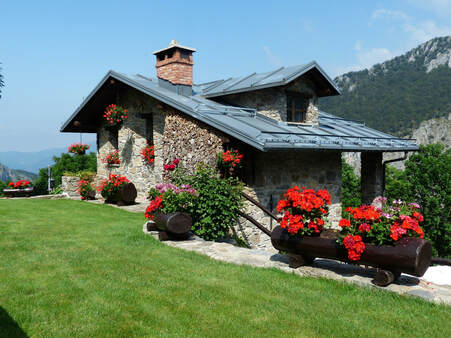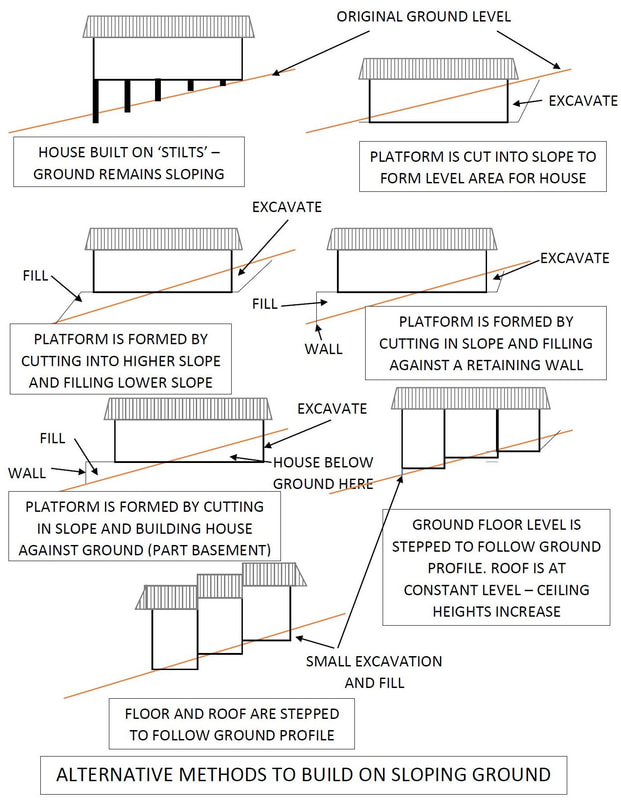|
Steeply sloping ground can add to building costs since usually the area under the house has to be levelled, which could entail bringing in additional ground, or it could mean excavating into the slope to create a level platform. But creating a level area may also require retaining walls to be constructed to hold the banks or sides of excavations up. These walls can be costly and also unsightly. An alternative to reduce the amount of earthmoving is to design the house so that it has steps and that the various rooms are built at differing levels to accommodate and follow the sloping ground. Sometimes semi-basements can be constructed which are built into the slope to minimise the filling. Another solution is to build the house on stilts or columns so that the floor of the house, which is level, overhangs the sloping ground. The columns get longer further down the slope. This can be expensive, especially if the columns and house floor are constructed of concrete. Potential problems for houses on slopesBut a steeply sloping property can create other problems which could include:
Want to learn more about designing, renovating and building houses?Paul Netscher has written 2 easy to read books 'An Introduction to Building and Renovating Houses - Volumes 1 and 2'. An Introduction to Building and Renovating Houses Volume 1 deals with Hiring Contractors, Managing Construction and Finishing Your Home. and Designing your ideal home Volume 2 deals with Finding Your Ideal Property and Designing Your Dream Home.
("Great for those that DIY. Very helpful in home renovations!" said a Reader on Amazon.com 5*****) These books are available from Amazon and other online bookstores in paper and ebook.
6 Comments
28/10/2022 12:12:49 pm
If you are looking for a concrete contractors near Columbus. Visit the website above
Reply
It really helped when you said that retaining walls are needed so that the banks or sides of excavation projects can be held up while the construction is ongoing. I can imagine how this kind of addition to the construction of our home is worth it if it means that the property will be protected for the duration of the project. Also, it might also be useful in the long run if we keep the walls, since a sloped piece of land can be prone to erosion when no proper installations are placed.
Reply
17/6/2023 08:48:16 am
My favorite part of this article is that one of the most important excavation processes is ensuring safe pipelines. Last week, my cousin told me that he was looking for a reliable excavation service for their unused plot of land that would be a commercial property. He asked if I had any idea what would be the best option to do. Thanks to this enlightening excavation guide article, I'll tell him he should consult a trusted land excavation service as they can provide more information about the process.
Reply
The alternative solutions mentioned in the article, such as designing the house with steps or constructing it on stilts, can indeed help mitigate some of the issues associated with sloping sites. However, it's important to carefully consider factors like vehicle access, drainage, and maintenance requirements when designing on such terrain. Additionally, implementing proper landscaping techniques, such as terracing, can help create more usable outdoor spaces. It's crucial for homeowners to thoroughly assess the advantages and disadvantages of building on sloping ground before proceeding with the project.
Reply
12/7/2023 04:36:05 pm
The points you mentioned about leveling the area, constructing retaining walls, and considering alternative designs are crucial for minimizing costs and maximizing the use of the sloping terrain.
Reply
22/9/2023 08:05:21 pm
The point about conducting a thorough site analysis is spot on. Understanding the soil composition, drainage patterns, and the degree of slope is essential for designing a structurally sound and aesthetically pleasing home. It's clear that a one-size-fits-all approach won't work when building on sloping ground, and customization based on site-specific factors is key.
Reply
Leave a Reply. |
AuthorI’m a construction professional, author of several successful construction management books, and a home owner. I’ve made mistakes in construction management, I’ve seen others make mistakes, but importantly I’ve had multiple successful construction projects and I’ve learned from the mistakes. I want to share these lessons and my knowledge with you. Also available from:
Amazon Au, Amazon DE, Amazon ES, Amazon CA, Amazon IT, Amazon FR, Amazon NL, Amazon India and 'An Introduction to Building Houses - Volume 2 Finding Your Ideal Property and Designing Your Dream Home'
Archives
July 2024
CategoriesWe welcome genuine comments, especially comments that add additional information to the subject matter in the article. We however reserve the right to remove inappropriate comments, which includes comments that have nothing to do with the subject, comments that include inappropriate language, and comments that are an advertisement for a product or company, or which include an advertising link. Comments must be in English. We will not enter into discussion on why a particular comment was removed.
|







 RSS Feed
RSS Feed


